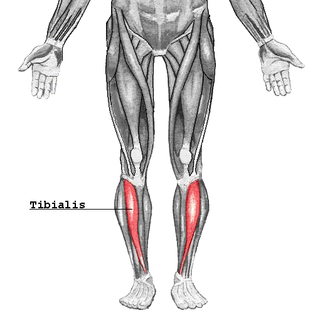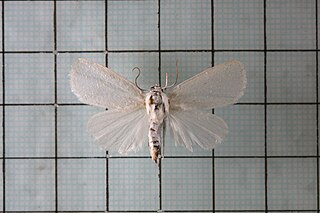
The tibialis posterior muscle is the most central of all the leg muscles, and is located in the deep posterior compartment of the leg. It is the key stabilizing muscle of the lower leg.

The tibialis anterior muscle is a muscle of the anterior compartment of the lower leg. It originates from the upper portion of the tibia; it inserts into the medial cuneiform and first metatarsal bones of the foot. It acts to dorsiflex and invert the foot. This muscle is mostly located near the shin.

The flexor digitorum longus muscle is situated on the tibial side of the leg. At its origin it is thin and pointed, but it gradually increases in size as it descends. It serves to flex the second, third, fourth, and fifth toes.

The black-thighed grosbeak is a large seed-eating bird in the family Cardinalidae, which is endemic to the mountains of Costa Rica and western Panama.
Tibialis is an adjectival form of tibia. It may refer to:

Avisauridae is a family of extinct enantiornithine dinosaurs from the Cretaceous period, distinguished by several features of their ankle bones. Depending on the definition used, Avisauridae is either a broad and widespread group of advanced enantiornithines, or a small family within that group, restricted to species from the Late Cretaceous of North and South America.

Chasmina is a genus of moths of the family Noctuidae.

Chasmina candida is a moth of the family Noctuidae described by Francis Walker in 1865. It is found from Indo-Australian tropics east to Fiji, including many islands of the Indian Ocean and Pacific.

Sesia tibialis, the American hornet moth, poplar clearwing borer or cottonwood crown borer, is a moth of the family Sesiidae. It is known from North America, including British Columbia, Colorado, Utah, Michigan, Montana, Washington, California and Arizona.

Zygoballus tibialis is a species of jumping spider native to Central America. It was first described by the arachnologist Frederick Octavius Pickard-Cambridge in 1901. The type specimens are housed at the Natural History Museum in London.

Argia tibialis, the blue-tipped dancer, is a species of narrow-winged damselfly in the family Coenagrionidae. It is found in Central America and North America.
Chasmina fasciculosa is a moth of the family Noctuidae first described by Francis Walker in 1858. It is found in Sri Lanka, Hong Kong, the Philippines and China.
Gettyia is an extinct genus of avisaurid enantiornithean bird from the Late Cretaceous of North America.

Reticulitermes tibialis, the arid-land subterranean termite, is a species of termite in the family Rhinotermitidae. It is found in the United States, mostly in the western half, occurring in deserts, prairies and other dry locations.

Xenorhynchopsis is an extinct genus of flamingo from the Pliocene to Pleistocene Lake Eyre basin of Australia. Initially described as species of stork, the two known Xenorhynchopsis species are vastly different in size. X. minor is the older and small of the two species, ranging from the Pliocene to Pleistocene and being described as having reached a size smaller than that of the lesser flamingo. X. tibialis meanwhile appears to have been restricted to Pleistocene strata and was notably bigger, being counted as one of the biggest known flamingos in the fossil record.












